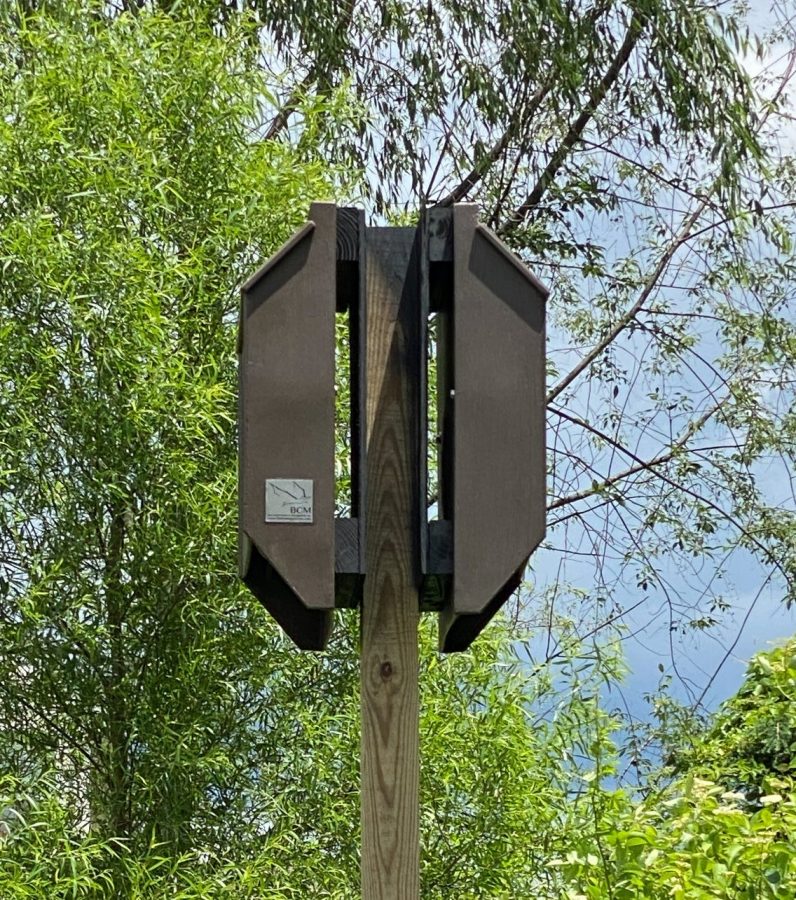Dual Protection: The Relationship between Bats and Hackley’s Orchard
Credit: Mark Green
The bat houses have been planted onto Hackley’s orchard. Surrounded by the beautiful scenery, the houses await for bats to settle into their forever homes. Until then, Mark Green and the other caretakers of the bat houses will continuously check and give updates to the community.
In order to maintain the healthy condition of Hackley’s orchard, the community has decided to bring in one of the most interesting and misunderstood species within the animal kingdom: bats. These animals are viewed differently by society, as their public image is clouded by the horror genre, creating an inaccurate and fear-based perspective. In truth, bats are generally non-violent creatures who tend to avoid confrontation with other animals.
The main purpose of bringing bats on campus is to have a protector for the botanic life from insect pests; thus providing a solution without having to use harmful insecticides. An article in Discovered Bats stated that a single bat could “catch more than 4,000 insects in a night.” These massive numbers not only demonstrate the impressive degree of pest-control bats are capable of, but also provide an ample reason for the placement of bat houses on campus. As a result, the bat boxes were placed during the summer of 2021, and are planned to house bats by 2024.
The orchard has two four-chambered bat houses, which can comfortably hold up to 400 bats within the spring and summer seasons.
According to Upper School Visual Arts teacher, Mark Green, a key contributor to the project, the houses need to be checked for various flaws before they can be used.
One needs to, “check for cracks, leaks, warping, or exposed unpainted wood that may need minor repairs,” he said, “Check for unwanted guests, like wasps, and remove any nests in late winter or early spring using a stick. New caulk and paint may be required after 3 – 5 years to prevent leaks and drafts.”
It is also highly suggested that the bat houses should be in an absolutely sanitary condition. All maintenance is to be done in “the months when bats are not present (November to early March)” said Mr. Green. Such an essential role is diligently done by Mr. Green, who is willing to put in all the time and effort necessary for this preparation.
In addition to maintaining the bat houses, it is critical to focus on protecting the bat species. The bat population has been suffering from the effects of White-nose syndrome, a fungal infestation that disturbs the bats’ hibernation. Once roused, the bats are forced to search for food in freezing temperatures and incompatible conditions which inevitably leads to their deaths.

Labelled with small bat stickers and standing strong, the bat houses continue to wait for its tenants! Once filled, the houses will serve as a major strongpoint for the overseers of Hackley’s orchard: the bats.
According to the National Park Service, bats are at risk of infection through “fungus from the surfaces of the cave or mine where they’re hibernating. Humans can spread the fungus from one hibernaculum to another by accidentally carrying the fungus on shoes, clothing, or gear.”
By offering sanitary, isolated houses for bats on the Hilltop, not only will they be safe, but they will also protect the orchard from unwanted pests. By nurturing this mutual exchange, Mr. Green hopes for the bats’ misunderstood reputation to be cleared, and lead the Hackley Orchard to a bright future.











